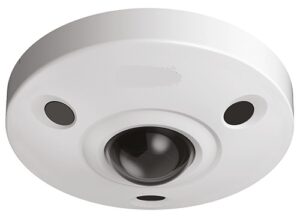When choosing a security camera system, it’s important to understand the differences between multi-sensor, single-sensor, and fisheye cameras. The pros and cons of each type vary based on your particular requirements. Here’s a breakdown to help you decide which is right for you: In this article, we’ll compare these three types of cameras to help you make an informed decision.
Understanding the Basics
Single Sensor Security Cameras
Single-sensor cameras are the most popular type of security camera, utilising a single image sensor to capture video footage. They come in various styles, such as bullet, dome, and PTZ (pan-tilt zoom) models, making them suitable for both residential and commercial applications.
Advantages:
Affordability: Typically less expensive than multi-sensor options.
Simplicity: Easier to install and operate.
Variety of Styles: Available in various styles (dome, bullet, etc.) to suit different environments.
Disadvantages:
Limited Coverage: They can create blind spots if not strategically placed.
Multiple Cameras Required: Larger areas may need several single-sensor cameras for adequate coverage.
Best For: Residential homes or small businesses where targeted monitoring is sufficient.
Multi-Sensor Security Cameras
Multi-sensor cameras feature multiple image sensors, usually ranging from two to four, all housed in a single unit. Each sensor captures a segment of the scene, and the camera’s software combines these images to produce a wide, seamless field of view. These cameras are particularly favoured for monitoring large areas that require extensive coverage
Advantages:
Wide Coverage: They can monitor large areas without needing multiple cameras.
Reduced blind spots: The multiple sensors can eliminate blind spots more effectively.
Cost-effective: Fewer cameras may mean lower installation costs.
Disadvantages:
Higher Initial Cost: Multi-sensor systems can be more expensive upfront compared to single-sensor cameras.
Complex Installation: They may require more sophisticated installation and configuration.
Best For: Large areas like parking lots or warehouses where comprehensive coverage is needed.
Fisheye Security Cameras
Fisheye cameras utilise a single sensor combined with an ultra-wide-angle lens to capture a 360-degree view. The lens’s curvature creates a panoramic or hemispherical image, enabling the camera to cover an entire room or open area without any blind spots. These cameras are commonly used in retail stores, offices, and various indoor environments.
Advantages:
Comprehensive View: Ideal for monitoring large spaces without any blind spots.
Panoramic Coverage: Can replace multiple cameras in some scenarios.
Flexible Viewing: Some models allow users to digitally pan and zoom into the footage.
Disadvantages:
Image Distortion: The wide-angle view can distort the image, making it harder to identify details.
Higher Cost: Generally more expensive than single sensor options.
Best For: Open spaces like retail stores, lobbies, or large rooms where a full view is needed.
Key Differences and Advantages
1. Field of View and Coverage
Single-sensor cameras typically offer a narrower field of view, ranging from 70 to 120 degrees. While adequate for many applications, covering large areas often requires multiple cameras, which can increase costs and complexity.
Multi-Sensor Cameras: Provide a much wider field of view, often exceeding 180 degrees, depending on the number of sensors. They are ideal for monitoring expansive areas like parking lots, stadiums, and large warehouses, minimising the need for multiple cameras.
Fisheye Cameras: Capture a full 360-degree view from a single point, effectively covering an entire room or area. This makes them highly effective indoors, where complete coverage is essential without multiple installations.
2. Image Quality and Resolution
Single-Sensor Cameras: Usually deliver high-resolution video, often in 4K, depending on the model. They provide excellent clarity and detail, but coverage is limited to the lens’s field of view.
Multi-Sensor Cameras: These cameras also offer high-resolution images; however, the resolution is distributed over a wider area, which may result in slightly lower clarity when zooming in on distant objects. Nonetheless, they still maintain good detail and overall coverage.
Fisheye Cameras: While they capture a broad view, the image can be distorted due to the lens curvature. Many modern fisheye cameras include de-warping software to correct this distortion, but the resolution may not match that of single-sensor cameras focused on a specific area.
3. Installation and Placement
Single-Sensor Cameras: Easy to install and versatile in placement. However, achieving comprehensive coverage in large areas may necessitate multiple cameras, increasing installation time and costs.
Multi-Sensor Cameras: Provide broader coverage with fewer devices, simplifying installation in large spaces. They are often mounted in corners or along walls to maximise their wide field of view.
Fisheye Cameras: Typically installed on ceilings at the centre of a room to ensure complete 360-degree coverage, making them ideal for indoor environments where a single camera needs to monitor the entire area.
4. Cost Considerations
Single-sensor cameras: generally the most affordable option, especially for small-scale installations. However, costs can escalate when multiple cameras are required for larger areas.
Multi-Sensor Cameras: Usually more expensive upfront than single-sensor options but can be more cost-effective over time by decreasing the number of cameras and installation points needed for wide-area coverage.
Fisheye Cameras: Pricing varies based on model and features, but they can offer cost savings by reducing the number of cameras necessary for full coverage. However, their image quality in larger spaces may not be as sharp as other types.
5. Use Cases
Single-Sensor Cameras: Best for focused monitoring in areas such as entryways, hallways, or places requiring high detail in a specific direction.
Multi-Sensor Cameras: Ideal for large, open spaces where wide coverage is needed without multiple cameras, such as parking lots, large retail stores, or industrial sites.
Fisheye Cameras: Perfect for indoor areas that require 360-degree coverage, such as offices, retail spaces, and warehouses, allowing full visibility with just one camera.
Conclusion: Which Camera is Right for You?
Choosing the right security camera depends on your specific needs.
- If you need detailed, focused coverage in a specific direction, a single-sensor camera might be the best option.
- For large areas requiring extensive coverage with minimal installation points, multi-sensor cameras offer an efficient and effective solution.
- If you want comprehensive coverage of a room or open area with a single device, a fisheye camera provides a panoramic view with minimal blind spots.
Each type of camera has its strengths, and the best choice depends on the environment you’re monitoring and your budget. By understanding the differences between single-sensor, multi-sensor, and fisheye cameras, you can select the best option to enhance your security system.


